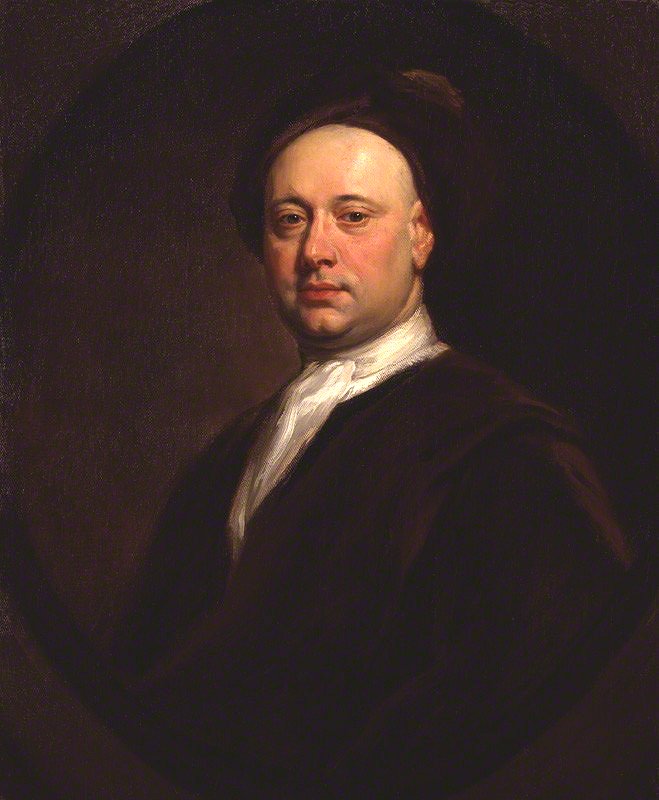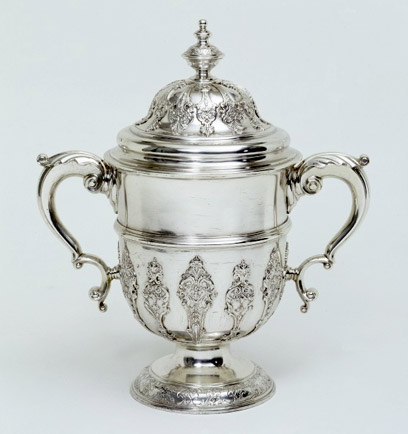|
Hubert-François Gravelot
Hubert-François Bourguignon, commonly known as Gravelot (26 March 1699 – 20 April 1773), was a French engraver, a famous book illustrator, designer and drawing-master. Born in Paris, he emigrated to London in 1732, where he quickly became a central figure in the introduction of the Rococo style in British design, which was disseminated from London in this period, through the media of book illustrations and engraved designs as well as by the examples of luxury goods in the "French taste" brought down from London to provincial towns and country houses. Education Gravelot was a mediocre student, who did not profit from a premature stay in Rome, financed by his father, from which he returned, his funds depleted, without a stay in Lyon, an artistic center that often provided a stop-over for art students between Paris and Rome. Unsuccessful in a commercial venture at Saint Domingue on his father's account, he returned to Paris and became the pupil first of Jean II Restout, and the ... [...More Info...] [...Related Items...] OR: [Wikipedia] [Google] [Baidu] |
Maurice Quentin De La Tour
Maurice Quentin de La Tour (5 September 1704 – 17 February 1788) was a French Rococo portraitist who worked primarily with pastels. Among his most famous subjects were Voltaire, Rousseau, Louis XV of France, Louis XV and Madame de Pompadour. Biography Maurice Quentin de La Tour was born in Saint-Quentin, Aisne, Saint-Quentin, the third son of a musician, François de La Tour. François was from Laon and he was the son of a master mason, Jean de La Tour, of Laon and Saint-Quentin, who died in 1674. François de La Tour apparently was successively a trumpet-player for the rifle regiment of the Duc du Maine, and musician to the master of the collegiate church of Saint-Quentin. He is popularly said to have disapproved of his son taking up the arts, but there is nothing to support this. According to François Marandet in 2002, an apprenticeship was arranged for the young Maurice, with a painter named Dupouch, from 12 October 1719, but it is not known when this contract was terminat ... [...More Info...] [...Related Items...] OR: [Wikipedia] [Google] [Baidu] |
Saint Domingue
Saint-Domingue () was a French colonization of the Americas, French colony in the western portion of the Caribbean island of Hispaniola, in the area of modern-day Haiti, from 1659 to 1804. The name derives from the Spanish main city in the island, Santo Domingo, which came to refer specifically to the Spanish-held Captaincy General of Santo Domingo, now the Dominican Republic. The borders between the two were fluid and changed over time until they were finally solidified in the Dominican War of Independence in 1844. The French had established themselves on the western portion of the islands of Hispaniola and Tortuga (Haiti), Tortuga by 1659. In the Treaty of Ryswick of 1697, Spain formally recognized French control of Tortuga Island and the western third of the island of Hispaniola. In 1791, slaves and some Saint Dominicans, Dominican Creoles took part in the Haitian Vodou, Vodou ceremony Bois Caïman and planned the Haitian Revolution. The slave rebellion later allied with Frenc ... [...More Info...] [...Related Items...] OR: [Wikipedia] [Google] [Baidu] |
St Martin's Lane
St Martin's Lane is a street in the City of Westminster, which runs from the church of St Martin-in-the-Fields, after which it is named, near Trafalgar Square northwards to Long Acre. At its northern end, it becomes Monmouth Street. St Martin's Lane and Monmouth Street together form the B404. History The street was first built up in 1610 when Robert Cecil, 1st Earl of Salisbury was granted of land on the street's west side. It was originally known as West Church Lane; the current name dates from 1618. A narrow street with relatively little traffic, St Martin's Lane is home to the English National Opera at the Coliseum Theatre, as well as two other theatres, the Duke of York's Theatre and the Noël Coward Theatre, second-hand bookshops, antique dealers and high class gentlemen's outfitters. It also has a large number of cafes and a music shop aimed at opera and theatre goers. The theatrical agency set up by Peggy Ramsay in 1953 was located in Goodwin's Court, an alley leadi ... [...More Info...] [...Related Items...] OR: [Wikipedia] [Google] [Baidu] |
Etui
The European Trade Union Institute (ETUI) is the independent research and training centre of the European Trade Union Confederation (ETUC). Its mission is to build bridges between the world of research and the world of labour, in order to support, strengthen and stimulate the European trade union movement. The ETUI places its expertise – acquired in particular in the context of its links with universities and specific academic and expert networks – in the service of workers’ interests at European level and of the strengthening of the social dimension of the European Union. In its present form, the ETUI is the result of the merger, in 2005, of the following three specialist bodies: the European Trade Union Institute (ETUI, founded in 1978), the European Trade Union College (ETUCO, founded in 1989) and the Trade Union Technical Bureau (TUTB – for occupational health and safety issues – also founded in 1989). The Institute is currently composed of two departments: * Resea ... [...More Info...] [...Related Items...] OR: [Wikipedia] [Google] [Baidu] |
Morgan Library
The Morgan Library & Museum, formerly the Pierpont Morgan Library, is a museum and research library in the Murray Hill neighborhood of Manhattan in New York City. It is situated at 225 Madison Avenue, between 36th Street to the south and 37th Street to the north. The Morgan Library & Museum is composed of several structures. The main building was designed by Charles McKim of the firm of McKim, Mead and White, with an annex designed by Benjamin Wistar Morris. A 19th-century Italianate brownstone house at 231 Madison Avenue, built by Isaac Newton Phelps, is also part of the grounds. The museum and library also contains a glass entrance building designed by Renzo Piano and Beyer Blinder Belle. The main building and its interior is a New York City designated landmark and a National Historic Landmark, while the house at 231 Madison Avenue is a New York City landmark. The site was formerly occupied by residences of the Phelps family, one of which banker J. P. Morgan had purchased in ... [...More Info...] [...Related Items...] OR: [Wikipedia] [Google] [Baidu] |
Metropolitan Museum Of Art
The Metropolitan Museum of Art of New York City, colloquially "the Met", is the largest art museum in the Americas. Its permanent collection contains over two million works, divided among 17 curatorial departments. The main building at 1000 Fifth Avenue, along the Museum Mile on the eastern edge of Central Park on Manhattan's Upper East Side, is by area one of the world's largest art museums. The first portion of the approximately building was built in 1880. A much smaller second location, The Cloisters at Fort Tryon Park in Upper Manhattan, contains an extensive collection of art, architecture, and artifacts from medieval Europe. The Metropolitan Museum of Art was founded in 1870 with its mission to bring art and art education to the American people. The museum's permanent collection consists of works of art from classical antiquity and ancient Egypt, paintings, and sculptures from nearly all the European masters, and an extensive collection of American and modern ... [...More Info...] [...Related Items...] OR: [Wikipedia] [Google] [Baidu] |
George Vertue
George Vertue (1684 – 24 July 1756) was an English engraver and antiquary, whose notebooks on British art of the first half of the 18th century are a valuable source for the period. Life Vertue was born in 1684 in St Martin-in-the-Fields, London, his father, perhaps a tailor, and mother are noted as 'Roman Catholic'. At the age of 13, he was apprenticed to a prominent heraldic engraver of French origin who became bankrupt and returned to France. Vertue worked seven years under Michael Vandergucht, before operating independently. He was amongst the first members of Godfrey Kneller's London Academy of Painting, who had employed him to engrave portraits. citing: Walpole's ''Anecdotes of Painting''; Nichols's ''Literary Anecdotes'', ii. 246; Chester's ''Westminster Abbey Reg.''; Dodd's manuscript ''Hist. of English Engravers'' in Brit. Mus. (Addit. MS. 33406). It was there that he became a pupil of Thomas Gibson, a leading portrait painter. Vertue had a deep interest in antiqu ... [...More Info...] [...Related Items...] OR: [Wikipedia] [Google] [Baidu] |
Bernard Picart
Bernard Picart or Picard (11 June 1673 – 8 May 1733), was a French draughtsman, engraver, and book illustrator in Amsterdam, who showed an interest in cultural and religious habits. Life Picart was born in rue Saint-Jacques, Paris as son of Etienne Picart, a famous engraver. In 1689, he studied drawing and architecture at the Académie royale de peinture et de sculpture. He was taught by Charles le Brun, along with Benoît Audran the Elder, Sébastien Leclerc and Antoine Coypel. In 1696 he wintered in Antwerp, where he was well-received. He stayed in Amsterdam for more than a year and had commissions before returning to France at the end of 1698. He took over his father's workshop. After his wife, Cloudina Pros, the daughter of a bookseller, and their children died, he settled in The Hague together with Prosper Marchand in January 1710. There Picart, Marchand and Charles Levier belonged to a "radical Huguenot coterie", who studied the works of John Locke, which promo ... [...More Info...] [...Related Items...] OR: [Wikipedia] [Google] [Baidu] |
Claude Du Bosc
Claude Du Bosc (also spelled Dubosc and DuBosc; –c. or after 1746) was a French engraver, publisher, and printseller who spent much of his career in London. Associated with French contemporaries such as the painter Antoine Watteau and the draftsman Hubert-François Gravelot, Du Bosc belonged to the first wave of skilled engravers to arrive in London during the early 18th century, playing a major part in improving the standard of English printmaking of that era. Life Nothing known of Du Bosc's early life and work; it has been usually thought since the late-19th century that Du Bosc was born in France c. 1682,In a widely represented point, , cited in , establishes c. 1682 and c. 1745 as respective datings of Du Bosc's birth and death. In a different point, , states that there are no actual datings for that. In light of the 1746 mention in the ''British Magazine'', recent sources such as and , date Du Bosc's death c. or after 1746. likely of Protestant background. In and Henri B ... [...More Info...] [...Related Items...] OR: [Wikipedia] [Google] [Baidu] |
Paul De Lamerie
Paul de Lamerie (9 April 1688 – 1 August 1751) was a London-based silversmith. The Victoria and Albert Museum describes him as the "greatest silversmith working in England in the 18th century". He was being referred to as the ‘King’s silversmith’ in 1717. Though his mark raises the market value of silver, his output was large and not all his pieces are outstanding. The volume of work bearing de Lamerie's mark makes it almost certain that he subcontracted orders to other London silversmiths before applying his own mark. Early and private life De Lamerie was born in 's-Hertogenbosch in the United Provinces (now the Netherlands). He was the son of a minor French nobleman, Paul Souchay de la Merie, a Huguenot who left France following the Edict of Fontainebleau in 1685. His father became an officer in the army of William III of Orange and moved to London in 1689 during the Glorious Revolution, but died a pauper in 1735. He married Louisa Juliott on 11 February 1717. They ... [...More Info...] [...Related Items...] OR: [Wikipedia] [Google] [Baidu] |
Huguenot
The Huguenots ( , also , ) were a religious group of French Protestants who held to the Reformed, or Calvinist, tradition of Protestantism. The term, which may be derived from the name of a Swiss political leader, the Genevan burgomaster Bezanson Hugues (1491–1532?), was in common use by the mid-16th century. ''Huguenot'' was frequently used in reference to those of the Reformed Church of France from the time of the Protestant Reformation. By contrast, the Protestant populations of eastern France, in Alsace, Moselle, and Montbéliard, were mainly Lutherans. In his ''Encyclopedia of Protestantism'', Hans Hillerbrand wrote that on the eve of the St. Bartholomew's Day massacre in 1572, the Huguenot community made up as much as 10% of the French population. By 1600, it had declined to 7–8%, and was reduced further late in the century after the return of persecution under Louis XIV, who instituted the '' dragonnades'' to forcibly convert Protestants, and then finally revoke ... [...More Info...] [...Related Items...] OR: [Wikipedia] [Google] [Baidu] |
Andien De Clermont
Andien de Clermont (died 1783) was a French artist who worked in England in the 18th century (c.1716–1756). He was particularly known for his decorative flower paintingsChaudon et Delandine, eds. Nouveau dictionnaire historique. Lyon: Bruyset, 1805 in the Rococo style, and for "singeries, chinoiseries, and turqueries."Jennifer D. Milam. Historical Dictionary of Rococo Art. Scarecrow Press, 2011 He decorated interiors at Kirtlington Park, Langley Hall, Wentworth Castle, Wilton House, and "the second earl of Strafford's (now destroyed) dining room at No. 5 St. James's Square St James's Square is the only square in the St James's district of the City of Westminster and is a garden square. It has predominantly Georgian and Neo-Georgian architecture. For its first two hundred or so years it was one of the three or fo ..., London." References Further reading * Ingrid Roscoe. "Andien de Clermont, Decorative Painter to the Leicester House Set." Apollo 123, 1986 External link ... [...More Info...] [...Related Items...] OR: [Wikipedia] [Google] [Baidu] |








